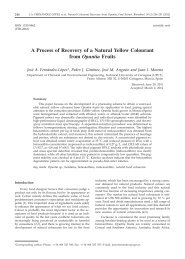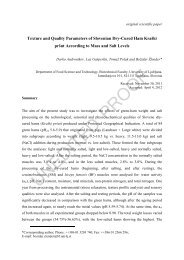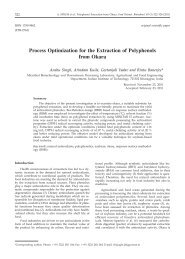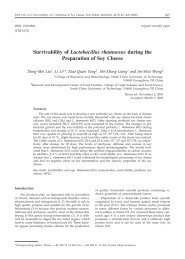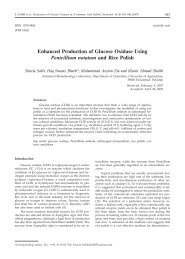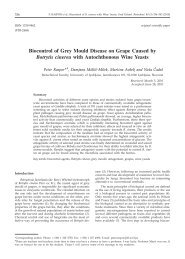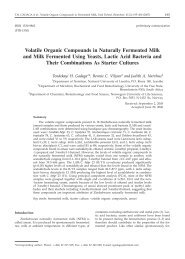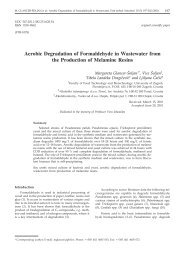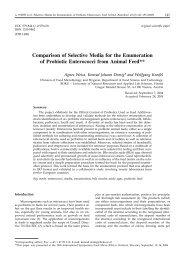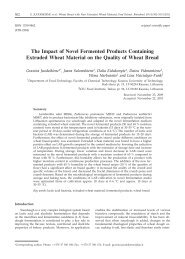Optimization of Bleaching Parameters for Soybean Oil
Optimization of Bleaching Parameters for Soybean Oil
Optimization of Bleaching Parameters for Soybean Oil
Create successful ePaper yourself
Turn your PDF publications into a flip-book with our unique Google optimized e-Paper software.
200 D. [KEVIN et al.: <strong>Soybean</strong> <strong>Oil</strong> <strong>Bleaching</strong> <strong>Parameters</strong>, Food Technol. Biotechnol. 50 (2) 199–207 (2012)loss <strong>of</strong> oxidative stability can occur, trans fatty acids can<strong>for</strong>m, and free fatty acid (FFA) content may increase(5–9). <strong>Optimization</strong> <strong>of</strong> bleaching parameters, mainly temperature,time, and clay content, is necessary in order tominimize these undesirable oil changes.If only the adsorbent properties <strong>of</strong> clay were important<strong>for</strong> bleaching, the most effective bleaching would occurat lower temperatures since at higher temperaturesthe adsorption equilibrium moves towards desorptionand some <strong>of</strong> the adsorbed molecules dissolve back intothe oil. However, decolouration is better at higher temperatures,which indicates that clay is much more thanan adsorbent. Indeed, chemical reactions take place onthe surface <strong>of</strong> the clay, and the kinetic constants <strong>of</strong> thesereactions, both desirable and undesirable, increase 2- to4-fold with a temperature increase <strong>of</strong> 10 °C (10). There<strong>for</strong>e,there must be an optimum temperature <strong>for</strong> bleaching,and this optimum likely depends on the type <strong>of</strong> oiland levels <strong>of</strong> colour bodies, oxidation products and contaminantspresent. Most types <strong>of</strong> oil are treated in thetemperature range <strong>of</strong> 90–100 °C (11), although bleachingmay be carried out at up to 120 °C if problems are expecteddue to oil specificities (4).The optimal bleaching time depends on the bleachingtemperature and clay quality. Colour removal increaseswith time and temperature, although longer contact<strong>of</strong> oil and clay can cause colour reversion, whichalso increases with temperature. <strong>Bleaching</strong> <strong>for</strong> a longtime at high temperatures seriously damages the oxidativestability <strong>of</strong> edible oil. <strong>Bleaching</strong> time <strong>for</strong> most types<strong>of</strong> oil is in the range <strong>of</strong> 20–30 min at 90–100 °C (4,12,13).High clay content enhances the removal <strong>of</strong> undesirablesubstances in the oil. However, the minimum clayneeded <strong>for</strong> effective bleaching is difficult to establish becausedifferent types <strong>of</strong> oil contain different amounts <strong>of</strong>substances and react differently with clay. Optimal claycontent depends on the type <strong>of</strong> clay, oil pretreatments,and desired quality <strong>of</strong> the oil. It varies between 0.1 and2.0%(14), but it can be as high as 5%inspecial cases (4).These considerations make clear that bleaching parameters,i.e. temperature, duration and clay content, shouldbe determined individually <strong>for</strong> each neutralized oil usingdifferent types <strong>of</strong> bleaching clay. The aim <strong>of</strong> this study isto optimize these bleaching conditions <strong>for</strong> neutralized soybeanoil with Pure-Flo ® Supreme Pro-Active bleachingclay on the laboratory scale, since optimal conditionshave not yet been reported <strong>for</strong> this type <strong>of</strong> vegetable oilbleached with this clay. The effect <strong>of</strong> these parameterson bleaching efficiency, oxidative stability and content <strong>of</strong>bioactive compounds (tocopherols and sterols) has beeninvestigated.Materials and MethodsStandards and chemicalsAll the standards used in this study were <strong>of</strong> HPLCgrade. The following compounds were obtained fromSigma-Aldrich (St. Louis, MO, USA): b-sitosterol (17-[5--ethyl-6-methyl-heptan-2-yl]-10,13-dimethyl-2,3,4,7,8,9,11,12,14,15,16,17-dodecahydro-1H-cyclopenta[a]phenanthren--3-ol), campesterol (17-[5,6-dimethylheptan-2-yl]-10,13--dimethyl-2,3,4,7,8,9,11,12,14,15,16,17-dodecahydro-1Hcyclopenta[a]phenanthren-3-ol),a-cholestanol (10,13-dimethyl-17-[6-methylheptan-2-yl]-2,3,4,5,6,7,8,9,11,12,14,15,16,17-tetradecahydro-1H-cyclopenta[a]phenanthren-3-ol), and stigmasterol (17-[5-ethyl-6-methyl-hept-3-en-2 --yl]-10,13-dimethyl-2,3,4,7,8,9,11,12,14,15,16,17-dodecahydro-1H-cyclopenta[a]phenanthren-3-ol).The compoundsa-tocopherol (2,5,7,8-tetramethyl-2-[4,8,12-trimethyltridecyl]-3,4-dihydrochromen-6-ol)and g–tocopherol (2,7,8--trimethyl-2-[4,8,12-trimethyltridecyl]-3,4-dihydrochromen-6-ol) were obtained from Merck (Darmstadt, Germany).All other chemicals were <strong>of</strong> suitable purity grade.MaterialsIndustrially neutralized soybean oil (Zvijezda d.d.,Zagreb, Croatia) was bleached using Pure-Flo ® SupremePro-Active bleaching clay (<strong>Oil</strong>-Dri Corporation <strong>of</strong> America,Chicago, IL, USA). This is an adsorbent manufacturedusing a proprietary surface modification technology (SMT).Raw material <strong>of</strong> the adsorbent is an intergrowth <strong>of</strong> hormiteand smectite minerals. SMT processing, combinedwith the intrinsic qualities <strong>of</strong> the mineral, produces ahighly active, fast-filtering product that removes coloursfrom corn, canola and soybean oil, in addition to removingsoaps, phospholipids and metals such as Ca, Fe,Mg and Ni. Manufacturer specifications <strong>of</strong> the bleachingclay (<strong>Oil</strong>-Dri Corporation <strong>of</strong> America) indicate a freemoisture content <strong>of</strong> 14–18 % at 105 °C and pH=2.4 to 3.3(5 % solids in deionized H 2 O).<strong>Bleaching</strong> <strong>of</strong> oil under laboratory conditionsLaboratory bleaching was per<strong>for</strong>med in a round--bottom, three-necked flask <strong>of</strong> 500 mL equipped with athermometer and attached to a vacuum pump and nitrogensource (Fisherbrand bleaching equipment, Fisherscientific Ltd, Loughborough, UK and Gast 0211 vacuumpump, Gast, Benton Harbor, MI, USA). <strong>Bleaching</strong> wasconducted using an electromagnetic mixer with adjustableheater. All bleaching parameters are given in Table1. Briefly, 200 g <strong>of</strong> industrially neutralized soybean oilwas weighed into a round-bottom, three-necked flaskTable 1. <strong>Bleaching</strong> parameters <strong>of</strong> soybean oil samplesSamplew(clay)%<strong>Bleaching</strong> parametersTimeminTemperature°C120 1052950.5303 1154 40 105595206 1157 130 105895409 1151020 10511951.53012 11513 40 105
D. [KEVIN et al.: <strong>Soybean</strong> <strong>Oil</strong> <strong>Bleaching</strong> <strong>Parameters</strong>, Food Technol. Biotechnol. 50 (2) 199–207 (2012)201and heated with mixing under a partial vacuum <strong>of</strong> 0.4bar. <strong>Bleaching</strong> clay was added to a final concentration <strong>of</strong>0.5, 1.0 or 1.5 % to the oil preheated to approx. 60 °C.The oil was then gradually heated to the desired bleachingtemperature (95, 105 or 115 °C) with constant mixingunder vacuum to disperse the clay completely. Afterreaching the desired temperature, the heating was temporarilyturned <strong>of</strong>f to allow the temperature to fall byapprox. 2–3 °C. Then the heating was turned on againand kept constant <strong>for</strong> the desired bleaching time (20, 30or 40 min). At the end <strong>of</strong> bleaching, heating and vacuumwere turned <strong>of</strong>f and nitrogen supply was turned on.After bleaching, hot sludge from the flask was filteredthrough filter paper (Whatman no. 541) under vacuum.Samples <strong>of</strong> bleached oil were stored at –18 °C untilfurther analysis.Analytical methodLovibond colour was determined according to theISO method (15) using Lovibond Colourscan (TintometerLtd., Amesbury, UK). Transparency was measured at 455nm on a Cary 100 Scan spectrophotometer (Varian, PaloAlto, CA, USA) following the method <strong>of</strong> O{tri}-Matija-{evi} et al. (16). Transparency <strong>of</strong> samples was measuredin undiluted oil using distilled water as a blank.The elements P, Fe and Cu in oil were determinedusing an inductively coupled plasma atomic emissionspectroscopy (ICP-AES) method (17,18) on a Vista-MPX(Varian). The three elements were analyzed by directinjection <strong>of</strong> a sample dissolved in PremiSolv ICP solvent(SCP Science, Conostan, Montreal, Quebec, Canada). Determination<strong>of</strong> the peroxide value (PV) was carried outfollowing ISO 3960:2007 analytical method (19) and theanisidine value following ISO 6885:2006 method (20).These two values were used to calculate the Totox (totaloxidation) value using <strong>for</strong>mulae from O{tri}-Matija{evi}and Turkulov (21). Specific UV absorption at 232 and 270nm (K 232 and K 270 , respectively) was measured followingISO 3656:2011 method (22). Free fatty acid (FFA) contentwas determined using ISO 660:2009 method (23).Sterol content and composition were determinedusing gas chromatography and ISO 12228:1999 method(24). The prepared sterol fraction (1 µL) was injectedinto a gas chromatograph (series 610, ATI Unicam, Cambridge,UK) equipped with a DB-17 capillary column (30m×0.32 mm×0.25 mm) containing 50 % phenyl-methylpolysiloxanestationary phase. Helium was used as carriergas at a flow rate <strong>of</strong> 0.36 mL/min. The temperature<strong>of</strong> the injector was set to 280 °C and the temperature <strong>of</strong>the detector to 290 °C. The temperature <strong>of</strong> the columnoven was programmed to increase at 6 °C/min from aninitial value <strong>of</strong> 180 to 270 °C, and then to remain at thisvalue <strong>for</strong> 30 min. Peaks were identified by comparingthe retention times <strong>of</strong> sterols with those <strong>of</strong> the standards.Quantification <strong>of</strong> all sterols was based on an internal standardmethod using a-cholestanol.Tocopherol content and composition were determinedusing a standard ISO method (25). Analysis wasper<strong>for</strong>med by high-per<strong>for</strong>mance liquid chromatography(HPLC) using a ProStar 363 (Varian) equipped with aProStar fluorescent detector and a Restek Pinnacle II silicacolumn (15 cm×4.6 mm, 5 µm). Sample was preparedby dissolving 0.1 g <strong>of</strong> soybean oil in 10 mL <strong>of</strong> n-hexane,and 20 µL <strong>of</strong> the solution was injected in the column.Detection <strong>of</strong> tocopherols was per<strong>for</strong>med at an excitationwavelength <strong>of</strong> 295 nm and emission wavelength <strong>of</strong> 330nm. Isocratic chromatography at room temperature wasused with a mobile phase <strong>of</strong> 0.7 % propan-2-ol in n-hexaneat a flow rate <strong>of</strong> 0.6 mL/min. Quantification <strong>of</strong> tocopherolswas per<strong>for</strong>med using standard calibration curves<strong>of</strong> a- and g-tocopherol covering the mass fraction range<strong>of</strong> 5–750 mg/kg.Statistical analysesA Box-Behnken design <strong>for</strong> three factors was used todesign the samples (26). The Friedman-type statistics <strong>for</strong>ranking the data was calculated to rank the samples accordingto bleaching efficiency and oxidative stability.Nonparametric analogues to Fisher’s least significantdifferences (LSD) <strong>for</strong> ranking the sums were calculated,and a multiple comparison procedure was per<strong>for</strong>med todetermine the significance <strong>of</strong> differences between thebleaching efficiency and oxidative deterioration parametersevaluated by the ranking test (27). Principal componentanalysis (PCA) was per<strong>for</strong>med to reduce thenumber <strong>of</strong> correlated variables, and to determine whichparameters significantly affected bleaching outcomes. Allstatistical analyses were per<strong>for</strong>med using the s<strong>of</strong>twarepackage STATISTICA v. 9 (28).Results and Discussion<strong>Bleaching</strong> was per<strong>for</strong>med on industrial neutralizedsoybean oil in the laboratory under vacuum and nitrogenatmosphere, using Pure-Flo ® Supreme Pro-Activebleaching adsorbent. The values <strong>for</strong> temperature, duration<strong>of</strong> bleaching and clay content tested in this studywere based on the literature (2,4,5,29) and on previousexperience with bleaching at the refining plant <strong>of</strong> theZvijezda oil factory, Zagreb, Croatia. Three bleachingtemperatures (95, 105 and 115 °C), three clay amounts(0.5, 1 and 1.5 %) and three bleaching durations (20, 30and 40 min) were tested. A Box-Behnken design <strong>for</strong>three factors was used to design the samples. The designconsisted <strong>of</strong> 12 different cases, with the 13th centralcase representing an average valuation <strong>of</strong> variables (Table1). All reported results are mean values <strong>of</strong> duplicate analyticaldeterminations.<strong>Bleaching</strong> efficiency was monitored by measuring thereduction in colour bodies, metal contaminants and oilretention by the bleaching clay. Colour bodies <strong>of</strong> oils andfats are pigments, primarily chlorophylls and carotenoids.<strong>Soybean</strong> oil contains small amounts <strong>of</strong> chlorophylls,and the main carotenoids are xanthophylls. Reduction <strong>of</strong>colour bodies in this work was measured according tothe Lovibond method (Table 2). The greatest reductionin red (72 %) and yellow units (26 %) in neutralized oilwas achieved using the highest clay content (1.5 %) atthe highest temperature (115 °C) during 30 min. Substantialremoval <strong>of</strong> colour substances makes the oil highlytransparent. The highest transparency, 12-fold greater thanthat <strong>of</strong> neutralized oil, was obtained with the highest claycontent, at higher temperature (105 and 115 °C) andthrough all time durations.
202 D. [KEVIN et al.: <strong>Soybean</strong> <strong>Oil</strong> <strong>Bleaching</strong> <strong>Parameters</strong>, Food Technol. Biotechnol. 50 (2) 199–207 (2012)Table 2. <strong>Parameters</strong> <strong>of</strong> bleaching efficiency <strong>for</strong> soybean oil samplesSampleLovibond colourw(Cu)w(Fe)w(P)Transparencyred units yellow unitsmg/kgmg/kgmg/kgNS 10.6 68.0 1.30 0.009 0.020 16.771 bd 7.3 68.0 5.64 0.002 0.001 13.442 b 8.2 69.0 5.08 0.000 0.000 12.653 bd 7.0 67.0 7.27 0.000 0.002 13.234 b 7.1 68.0 6.72 0.000 0.005 13.005 a 5.4 68.0 12.76 0.005 0.006 9.846 ab 4.3 69.0 13.73 0.000 0.000 10.727 bcd 8.2 69.0 12.44 0.000 0.000 11.008 ab 5.0 68.0 11.60 0.006 0.003 10.549 ab 4.3 69.0 12.77 0.000 0.003 11.5510 ac 3.4 62.0 16.13 0.000 0.006 10.1911 a 3.4 69.0 14.91 0.002 0.000 9.7912 ac 3.0 50.0 15.95 0.002 0.000 10.3313 ad 3.3 70.0 15.17 0.013 0.005 7.22NS=neutralized soybean oil<strong>Bleaching</strong> parameters <strong>for</strong> each sample are given in Table 1Samples with different letters in superscript differ significantly (p£0.05)Maximum mass fraction <strong>of</strong> Cu or Fe permitted inbleached oil is 0.1 mg/kg (4,8,30). All samples in thiswork had metal traces far below 0.1 mg/kg (Table 2).Phospholipids have good emulsifying properties andcan cause losses <strong>of</strong> neutral oil during refining. There<strong>for</strong>e,they have to be removed, mainly by degummingor to a lesser extent by bleaching. Phospholipid eliminationis checked indirectly by analyzing phosphorus content.Maximum bleaching should decrease the level <strong>of</strong>phosphorus in oil to 10 mg/kg (2). Table 2 shows thathigher clay amounts and lower temperatures reducedphosphorus content. The best result (7.22 mg/kg) wasachieved by bleaching <strong>for</strong> 40 min at 105 °C using 1.5 %clay.The results in Table 2 were analyzed by the Friedman-typestatistics <strong>for</strong> ranking the data (27), whichshowed that bleaching <strong>of</strong> neutralized soybean oil wasthe most efficient when per<strong>for</strong>med <strong>for</strong> 30 min at thelowest temperature (95 °C) and using the highest clayamount (1.5 %). Fisher’s LSD <strong>for</strong> ranking the sums <strong>of</strong>the examined samples were calculated and a multiplecomparison procedure was per<strong>for</strong>med to identify significantdifferences in bleaching efficiency among the samples(p£0.05). Clay content was the most important factorcausing differences between samples. The same conclusionwas obtained when the results were analyzed usingPCA (Fig. 1).PCA conducted on the results from Table 2 showedthat only the first two <strong>of</strong> six principal components (PCs)have eigenvalues >1 and together they explain morethan 76 % <strong>of</strong> the total variance. Fig. 1a shows a plot <strong>of</strong>the original variables <strong>for</strong> the first two PCs obtained fromthe PCA analysis <strong>of</strong> the data on bleaching efficiency.PC1 has a high positive correlation with red units andamount <strong>of</strong> phosphorus, and high negative correlationwith transparency. Fig. 1b shows a loading plot <strong>for</strong> thefirst two PCs. Samples fell into three groups along thePC1 based on the amount <strong>of</strong> clay content used <strong>for</strong> bleaching.Samples bleached with a higher amount <strong>of</strong> clayshowed higher transparency and lower levels <strong>of</strong> redunits and phosphorus than the samples bleached withlower amounts <strong>of</strong> clay.Fig. 1. PCA loading (a) and score (b) <strong>of</strong> the plots <strong>of</strong> the data on bleaching efficiency. Samples in b are described in Table 1
D. [KEVIN et al.: <strong>Soybean</strong> <strong>Oil</strong> <strong>Bleaching</strong> <strong>Parameters</strong>, Food Technol. Biotechnol. 50 (2) 199–207 (2012)203<strong>Bleaching</strong> clay accelerates oxidation <strong>of</strong> oil because<strong>of</strong> its high specific area and high catalytic activity. As aresult, bleached oil has the lowest oxidative stabilityamong the oils obtained during the various stages <strong>of</strong>refining (8). Thus, it is strongly recommended that bleachingbe conducted under vacuum, which significantly reduces,but does not eliminate, oxidation. Table 3 showsoxidative deterioration <strong>of</strong> the soybean oil samples bleachedunder vacuum (0.4 bar) and different conditions. Theperoxide value (PV) indexes the amount <strong>of</strong> oxygen thathas reacted with the oil, resulting in the <strong>for</strong>mation <strong>of</strong>hydroperoxides. The reduction in PV during bleachingwas 14–36 %, and the lowest PV was achieved with 1and 1.5 % clay at 95 and 115 °C, respectively. The bestPV obtained here (0.9 mmol <strong>of</strong> O 2 per kg) was higherthan the 0.5 mmol <strong>of</strong> O 2 per kg reported by Doleschall etal. (31) and Ortega-García et al. (32). Our higher PV mayreflect the relatively high phosphorus content <strong>of</strong> 16.77mg/kg in the neutralized soybean oil that was bleached.Wang (2) has suggested that low levels <strong>of</strong> phosphorus(5–10 mg/kg) in neutralized oil are required to maximizethe bleaching effect. These hydroperoxides can beremoved during the final refining stage <strong>of</strong> deodorizationin the <strong>for</strong>m <strong>of</strong> low molecular mass carbonyl compoundsthat arise from hydroperoxide breakdown during bleaching.These secondary oxidation products can be measuredusing the anisidine value (AV). Table 3 shows thatsamples with higher PV had lower AV, and vice versa.Higher AVs occurred at higher clay amounts, higherbleaching temperatures, and longer bleaching times. Thelowest AV (3.3) was obtained by bleaching <strong>for</strong> 30 min at95 °C using 0.5 % clay. This value is slightly higher thanthe previously published values <strong>for</strong> edible soybean oil,which range from 1.5 to 2.5 (31,33). Although our valuewas higher, our method may still be adequate <strong>for</strong> industrialproduction, since deodorization usually removes suchsecondary oxidation products.Since PV and AV index only part <strong>of</strong> oxidative deterioration,we determined Totox values <strong>of</strong> our samples.Totox combines PV and AV to act as a marker <strong>of</strong> oil oxidativehistory and current oxidation status. High qualityoil should have a Totox value under 10 (34). Accordingto this indicator, bleaching at 95 °C gave the highestquality oil (Table 3).Decomposition <strong>of</strong> hydroperoxides and isomerization<strong>of</strong> unsaturated fatty acids lead to the <strong>for</strong>mation <strong>of</strong> conjugateddienes and trienes, which show absorption maximaat 232 and 270 nm, respectively. These compoundsare very unstable to oxidation and are much more sensitivethan oleic and linoleic acids, so bleaching parametersshould be chosen to avoid <strong>for</strong>mation <strong>of</strong> these compounds.In our study, oil treated with higher clay contenthad lower levels <strong>of</strong> conjugated dienes than the neutralizedoil (Table 3). On the other hand, all samples hadmore conjugated trienes than the neutralized oil. <strong>Oil</strong>bleached using 0.5 % clay showed the lowest amounts<strong>of</strong> these compounds. For crude soybean oil intended <strong>for</strong>margarine production, Kondal Reddy et al. (35) recommendeda maximum absorption <strong>of</strong> 3.3 at 232 nm, andthey suggested that soybean oil with absorption above 4at 270 nm would give a final product with bad sensorycharacteristics. All <strong>of</strong> our samples gave absorbances belowthese values (Table 3).Although the oil bleaching process normally does notincrease the content <strong>of</strong> FFA, this can occur after hydrolysis<strong>of</strong> triglycerides. It can be suppressed by properlydrying the oil be<strong>for</strong>e bleaching and choosing clay thatcontains enough water necessary to become fully activebut not more (5). Pure-Flo ® Supreme Pro-Active clay, used<strong>for</strong> bleaching in this work, has a water content <strong>of</strong> 14–18% and a pH <strong>of</strong> 2.4–3.3 (<strong>Oil</strong>-Dri Corporation <strong>of</strong> America).The increase in FFA in our samples during bleaching wasminimal (Table 3), with a relative increase <strong>of</strong> 1 % overTable 3. <strong>Parameters</strong> <strong>of</strong> oxidative deterioration in bleached soybean oil samplesSamplebAnisidine TotoxAbsorbancew(free fatty acids)*mmol <strong>of</strong> O 2 per kg value value A 232 nm A 270 nm%NS 1.4 1.5 4.3 2.96 0.38 0.101 ac 2.1 3.6 7.8 3.05 1.20 0.072 a 1.7 3.3 6.7 3.04 1.09 0.093 bc 3.7 6.0 13.4 3.43 1.64 0.104 ab 3.5 4.2 11.2 3.12 1.39 0.115 a 1.1 4.1 6.3 2.81 1.73 0.096 ab 1.2 9.8 12.2 2.81 2.58 0.097 ab 1.9 6.7 10.5 2.83 2.19 0.118 ac 2.3 3.7 8.3 2.82 2.00 0.119 b 2.5 10.5 15.5 3.21 2.67 0.1110 ab 1.5 9.0 12.0 2.58 2.51 0.0711 ab 1.9 6.8 10.6 2.61 2.27 0.0912 bc 0.9 14.5 16.2 2.95 3.08 0.1013 bc 1.8 10.4 14.0 2.93 2.74 0.06b=peroxide value, NS=neutralized soybean oil<strong>Bleaching</strong> parameters <strong>for</strong> each sample are given in Table 1Samples with different letters in superscript differ significantly (p£0.05)*in % <strong>of</strong> oleic acid
204 D. [KEVIN et al.: <strong>Soybean</strong> <strong>Oil</strong> <strong>Bleaching</strong> <strong>Parameters</strong>, Food Technol. Biotechnol. 50 (2) 199–207 (2012)neutralized oil occurring in only 4 samples. This indicatesthat the clay used is suitable <strong>for</strong> soybean oil bleaching.The Friedman-type rank test showed that soybeanoil bleached <strong>for</strong> 20 min at 95 °C using 1 % clay had thebest oxidative stability. Fisher’s LSD <strong>for</strong> ranking the sumsshowed statistically significant differences among thesamples (p£0.05), due primarily to the influence <strong>of</strong> temperatureand secondarily to the influence <strong>of</strong> clay content.PCA was also per<strong>for</strong>med on parameters <strong>of</strong> oxidativedeterioration. The first two PCs had an eigenvalue >1and together they explained 80 % <strong>of</strong> the total variance.Score plot (parameters <strong>of</strong> oxidative deterioration and FFA)and loading plot (samples <strong>of</strong> bleached oil) as a function<strong>of</strong> PC1 and PC2 are shown in Figs. 2a and 2b, respectively.Fig. 2a shows a high negative correlation <strong>of</strong> PC1with the indicators <strong>of</strong> secondary oxidation products,while PC2 has a good positive correlation with primaryoxidation products. Fig. 2b shows that although thesamples do not fall into non-overlaping groups based onthe oxidative deterioration, soybean oil samples bleachedwith 1 or 1.5 % clay at 115 °C fall to the left side alongthe PC1. These samples have higher values <strong>of</strong> AV andK 270 . No clustering <strong>of</strong> samples is evident along PC2.These findings suggest that clay amount and bleachingtemperature had a strong influence on the secondary oxidationproducts, but no effect on the primary oxidationproducts.The Friedman-type rank test was applied to all resultsin Tables 2 and 3. It indicated that sample 5 showedthe most efficient bleaching with minimum oxidativedeterioration <strong>of</strong> the oil; this sample was bleached <strong>for</strong> 20min at 95 °C using 1 % clay.The influence <strong>of</strong> bleaching conditions on the contentand composition <strong>of</strong> bioactive components <strong>of</strong> soybean oilwas also examined. These analyses were carried out ona subset <strong>of</strong> samples bleached at different temperaturesusing different clay amounts, since statistical tests <strong>of</strong> theresults showed that the duration <strong>of</strong> bleaching had nosignificant influence on bleaching efficiency or oxidativedeterioration <strong>of</strong> oil. Of course, the sample bleachedusing optimal parameters <strong>of</strong> 1 % clay, 95 °C and 20 minwas also included.Bioactive compounds in vegetable oil, including soybeanoil, contribute to their oxidative stability and nutritionalvalue. The most important bioactive componentsare tocopherols, strong antioxidants with a significant biologicaleffect. Levels <strong>of</strong> total and individual tocopherolsdecrease during neutralization, bleaching and deodorization(6,36). Table 4 presents the content and composition<strong>of</strong> tocopherols <strong>of</strong> selected soybean oil samples. Thedominant tocopherol is g-tocopherol, as reported in previousstudies (8,36,37). It is obvious that the levels <strong>of</strong> a-and g-tocopherol in the neutralized oil decreased duringbleaching. This reduction was greater when increasingclay content and bleaching temperature. The levels <strong>of</strong> d--tocopherol and total tocopherols also decreased, butthere was no significant association with clay content ortemperature. The Friedman-type rank test showed thatthe sample bleached at 105 °C using 1 % clay had thehighest levels <strong>of</strong> individual and total tocopherols. TheFisher’s LSD <strong>for</strong> ranking the sums confirmed that thesamples with different clay content and bleaching temperatureshowed significant differences (p£0.05). In fact,the bleaching parameters found to be optimal based onthe bleaching efficiency and oxidative deterioration <strong>of</strong> soybeanoil (1 % clay, 95 °C and 20 min) did not give opti-Table 4. Tocopherol content and composition <strong>of</strong> bleached soybeanoil samplesw(tocopherol)Samplemg/kga-tocopherol g-tocopherol d-tocopherol TotalNS 87.1 431.7 202.8 721.62 c 62.6 405.1 167.9 635.63 b 54.0 403.6 199.5 657.15 d 47.6 388.2 171.3 607.17 a 51.9 410.6 210.2 672.611 c 42.4 399.2 201.5 643.012 d 41.3 376.1 198.3 615.7NS=neutralized soybean oil<strong>Bleaching</strong> parameters <strong>for</strong> each sample are given in Table 1Samples with different letters in superscript differ significantly(p£0.05)Fig. 2. PCA loading (a) and score (b) <strong>of</strong> the plots <strong>of</strong> the data on oil deterioration during the process <strong>of</strong> bleaching. Samples in b aredescribed in Table 1
206 D. [KEVIN et al.: <strong>Soybean</strong> <strong>Oil</strong> <strong>Bleaching</strong> <strong>Parameters</strong>, Food Technol. Biotechnol. 50 (2) 199–207 (2012)clay at 95 °C) fell on the negative side <strong>of</strong> PC2. Thosesamples contain lower amounts <strong>of</strong> all tocopherols. Wecan conclude that increasing the bleaching temperaturecan decrease the amount <strong>of</strong> total and individual sterols,and that higher amounts <strong>of</strong> clay can lead to lower levels<strong>of</strong> tocopherols.ConclusionIndicators <strong>of</strong> the efficiency <strong>of</strong> soybean oil bleachingwere strongly affected by the amount <strong>of</strong> Pure-Flo ® SupremePro-Active bleaching adsorbent used. <strong>Bleaching</strong>with 1.5 % clay gave significantly greater transparencyand lower levels <strong>of</strong> red units and phosphorus. <strong>Bleaching</strong>with higher amounts <strong>of</strong> clay at higher temperatures resultedin significantly greater levels <strong>of</strong> secondary oxidationproducts, based on the AV values and absorbanceat 270 nm. In contrast, the <strong>for</strong>mation <strong>of</strong> primary oxidationproducts was not significantly influenced by thebleaching parameters analyzed.<strong>Soybean</strong> oil bioactive compounds were influencedby the investigated bleaching conditions. <strong>Oil</strong> samplesbleached with high amount <strong>of</strong> clay had a lower content<strong>of</strong> a-tocopherol, g-tocopherols and total tocopherols. Sterolsdecreased with higher bleaching temperature.The most suitable parameters <strong>for</strong> bleaching soybeanoil with Pure-Flo ® Supreme Pro-Active bleaching claywere 1 % adsorbent at 95 °C <strong>for</strong> 20 min, although theseparameters were not the best choice <strong>for</strong> tocopherol preservation.<strong>Bleaching</strong> is only part <strong>of</strong> oil refining processand certain negative effects can be corrected during deodorization,such as reducing secondary products <strong>of</strong> oxidation,or during stabilization <strong>of</strong> edible soybean oil, suchas adding tocopherols in accordance with internationaland Croatian legislation (40,42). We believe that these optimizedparameters <strong>for</strong> bleaching soybean oil using Pure--Flo ® Supreme Pro-Active clay can be applied to industrialconditions. We expect substantial cost savings andthe production <strong>of</strong> contaminant-free, edible soybean oilwith high oxidative stability.AcknowledgementThis study was part <strong>of</strong> research project no. 058069-60704 supported by the Ministry <strong>of</strong> Science, Educationand Sports <strong>of</strong> the Republic <strong>of</strong> Croatia.References1. FAOSTAT, The Food and Agriculture Organization <strong>of</strong> theUnited Nations (FAO), Rome, Italy (2011) (http://faostat.fao.org).2. T. Wang: <strong>Soybean</strong> <strong>Oil</strong>. In: Vegetable <strong>Oil</strong>s in Food Technology– Composition, Properties and Uses, F.D. Gunstone (Ed.), BlackwellPublishing Ltd, Ox<strong>for</strong>d, UK (2002) pp. 18–58.3. D. Anderson: Edible <strong>Oil</strong> and Fat Products: Processing Technologies.In: Bailey’s Industrial <strong>Oil</strong> and Fat Products, Vol. 5,F. Shahidi (Ed.), John Wiley & Sons, Inc., Hoboken, NJ, USA(2005) pp. 16–48.4. W. Zschau: <strong>Bleaching</strong>. In: Introduction to Fats and <strong>Oil</strong>s Technology,R.D. O’Brien, W.E. Farr, P.J. Wan (Eds.), AOCS Press,Champaign, IL, USA (2000) pp. 158–178.5. W. Zschau, <strong>Bleaching</strong> <strong>of</strong> edible fats and oils, Eur. J. LipidSci. Technol. 103 (2001) 505–508.6. S. Naz, S.T.H. Sherazi, F.N. Talpur, Changes <strong>of</strong> total tocopheroland tocopherol species during sunflower oil processing,J. Am. <strong>Oil</strong> Chem. Soc. 88 (2011) 127–132.7. T. Verleyen, U. Sosinska, S. Ioannidou, R. Verhé, K. Dewettinck,A. Huyghebaert, W. De Greyt, Influence <strong>of</strong> the vegetableoil refining process on free and esterified sterols, J.Am. <strong>Oil</strong> Chem. Soc. 79 (2002) 947–953.8. M.Y. Jung, S.H. Yoon, D.B. Min, Effects <strong>of</strong> processing stepson the contents <strong>of</strong> minor compounds and oxidation <strong>of</strong> soybeanoil, J. Am. <strong>Oil</strong> Chem. Soc. 66 (1989) 118–120.9. M. Tasan, M. Demirci, Trans FA in sunflower oil at differentsteps <strong>of</strong> refining, J. Am. <strong>Oil</strong> Chem. Soc. 80 (2003) 825–827.10. R. Brdi~ka: Fundamentals <strong>of</strong> Physical Chemistry, VEB GermanAcademic Publishers, Berlin, Germany (1965) (in German).11. E.L. Foletto, G.C. Collazzo, C. Volzone, L.M. Porto, Sunfloweroil bleaching by adsorption onto acid-activated bentonite,Braz. J. Chem. Eng. 28 (2011) 169–174.12. A.D. Rich, Some basic factors in bleaching <strong>of</strong> fatty oils, J.Am. <strong>Oil</strong> Chem. Soc. 41 (1964) 315–321.13. E.L. Foletto, C. Volzone, L.M. Porto, Per<strong>for</strong>mance <strong>of</strong> an Argentinianacid-activated bentonite in the bleaching <strong>of</strong> soybeanoil, Braz. J. Chem. Eng. 20 (2003) 139–145.14. E.L. Foletto, C. Volzone, L.M. Porto, Clarification <strong>of</strong> cottonseedoil: How structural properties <strong>of</strong> treated bentonitesby acid affect bleaching efficiency, Lat. Am. Appl. Res. 36(2006) 37–40.15. Animal and Vegetable Fats and <strong>Oil</strong>s – Determination <strong>of</strong>Lovibond Colour, ISO Method 15305:1998, Geneva, Switzerland(1998).16. B. O{tri}-Matija{evi}, J. Turkulov, D. Karlovi}, Quality <strong>of</strong>sunflower oil bleached during deodorization, J. Am. <strong>Oil</strong>.Chem. Soc. 57 (1980) 323–325.17. Determination <strong>of</strong> Trace Metals, AOCS Official Method Ca20-99, AOCS International, Gaithersburg, MD, USA (1999).18. Determination <strong>of</strong> Trace Metals, AOCS Official Method Ca17-01, AOCS International, Gaithersburg, MD, USA (2001).19. Animal and Vegetable Fats and <strong>Oil</strong>s – Determination <strong>of</strong>Peroxide Value – Iodometric (Visual) Endpoint Determination,ISO Method 3960:2007, Geneva, Switzerland (2007).20. Animal and Vegetable Fats and <strong>Oil</strong>s – Determination <strong>of</strong>Anisidine Value, ISO Method 6885:2006, Geneva, Switzerland(2006).21. B. O{tri}-Matija{evi}, J. Turkulov: <strong>Oil</strong> and Fat Technology,Part 1, Faculty <strong>of</strong> Technology, University <strong>of</strong> Novi Sad, NoviSad, Serbia (1980) pp. 175–205 (in Serbian).22. Animal and Vegetable Fats and <strong>Oil</strong>s – Determination <strong>of</strong>Ultraviolet Absorbance Expressed as Specific UV Extinction,ISO Method 3656:2011, Geneva, Switzerland (2011).23. Animal and Vegetable Fats and <strong>Oil</strong>s – Determination <strong>of</strong>Acid Value and Acidity, ISO Method 660:2009, Geneva,Switzerland (2009).24. Animal and Vegetable Fats and <strong>Oil</strong>s – Determination <strong>of</strong>Individual and Total Sterols Contents – Gas ChromatographicMethod, ISO Method 12228:1999, Geneva, Switzerland(1999).25. Animal and Vegetable Fats and <strong>Oil</strong>s – Determination <strong>of</strong>Tocopherols and Tocotrienols Content by High-Per<strong>for</strong>manceChromatography, ISO Method 9936:2006, Geneva, Switzerland(2006).26. e-Handbook <strong>of</strong> Statistical Methods, NIST/SEMATECH, Gaithersburg,MD, USA (2011) (http://www.itl.nist.gov/div898/handbook/).27. M. Meilgaard, M.G. Civille, B.T. Carr: Sensory EvaluationTechniques, CRC Press, Inc. Boca Raton, FL, USA (1991).28. STATISTICA (Data Analysis S<strong>of</strong>tware System) v. 9, Stat-S<strong>of</strong>t, Inc, Tulsa, OK, USA (2009) (www.stats<strong>of</strong>t.com).29. M. Bockisch: Fats and <strong>Oil</strong>s Handbook, AOCS Press, Champaign,IL, USA (1998) pp. 613–719.
D. [KEVIN et al.: <strong>Soybean</strong> <strong>Oil</strong> <strong>Bleaching</strong> <strong>Parameters</strong>, Food Technol. Biotechnol. 50 (2) 199–207 (2012)20730. H.B.W. Patterson: <strong>Bleaching</strong> and Purifying Fats and <strong>Oil</strong>s –Theory and Practice, AOCS Press, Champaign, IL, USA (1992).31. F. Doleschall, Z. Kemény, K. Recseg, K. Ko"vári, A newanalitical method to monitor lipid peroxidation duringbleaching, Eur. J. Lipid Sci. Technol. 104 (2002) 14–18.32. J. Ortega-García, L.A. Medina-Juárez, N. Gámez-Meza,J.A. Noriega-Rodriguez, Optimisation <strong>of</strong> bleaching conditions<strong>for</strong> soybean oil using response surface methodology,Food Sci. Technol. Int. 11 (2005) 443–449.33. L.A. Medina-Juáres, P. Gonzáles-Días, N. Gámes-Meza, J.Ortega-García, A.B. Moreno-Varela, L. Bringas-Alvarado,O. Angulo-Guerrero, Effects <strong>of</strong> procesing on the oxidativestability <strong>of</strong> soybean oil produced in Mexico, J. Am. <strong>Oil</strong>Chem. Soc. 75 (1998) 1729–1733.34. J.B. Rossell, J.L.R. Pritchard: Analysis <strong>of</strong> <strong>Oil</strong>seeds, Fats andFatty Foods, Elsevier Science Publishers Ltd, Amsterdam,The Netherlands (1991) pp. 25–26.35. K. Kondal Reddy, R. Subramanian, T. Kawakatsu, M. Nakajima,Decolorization <strong>of</strong> vegetable oils by membrane processing,Eur. Food Res. Technol. 213 (2001) 212–218.36. J. Costa, J.S. Amaral, I. Mafra, M.B.P.P. Oliveira, Refining<strong>of</strong> Roundup Ready ® soya bean oil: Effect on the fatty acid,phytosterol and tocopherol pr<strong>of</strong>iles, Eur. J. Lipid Sci. Technol.113 (2011) 528–535.37. R.A. Ferrari, E. Schulte, W. Esteves, L. Brühl, K.D. Mukherjee,Minor constituents <strong>of</strong> vegetable oils during industrialprocessing, J. Am. <strong>Oil</strong> Chem. Soc. 73 (1996) 587–592.38. J. Plat, R.P. Mensink, Effects <strong>of</strong> plant sterols and stanols onlipid metabolism and cardiovascular risk, Nutr. Metab.Cardiovasc. 11 (2001) 31–40.39. E.T. Akintayo, Characteristics and composition <strong>of</strong> Parkia biglobbossaand Jatropha curcas oils and cakes, Bioresour. Technol.92 (2004) 307–310.40. Codex Standard <strong>for</strong> Named Vegetable <strong>Oil</strong>s, CODEX STAN210-1999, FAO and WHO, Rome, Italy (2011) (www.codexalimentarius.net/download/standards/336/CXS210e.pdf).41. Regulation on edible oils and fats, Official Gazette <strong>of</strong> the Republic<strong>of</strong> Croatia No. 22/2010 (2010) (in Croatian).42. Regulation on food additives, Official Gazette <strong>of</strong> the Republic<strong>of</strong> Croatia No. 62/2010 (2010) (in Croatian).




